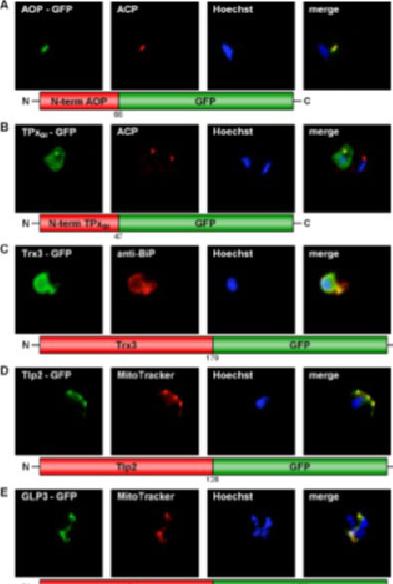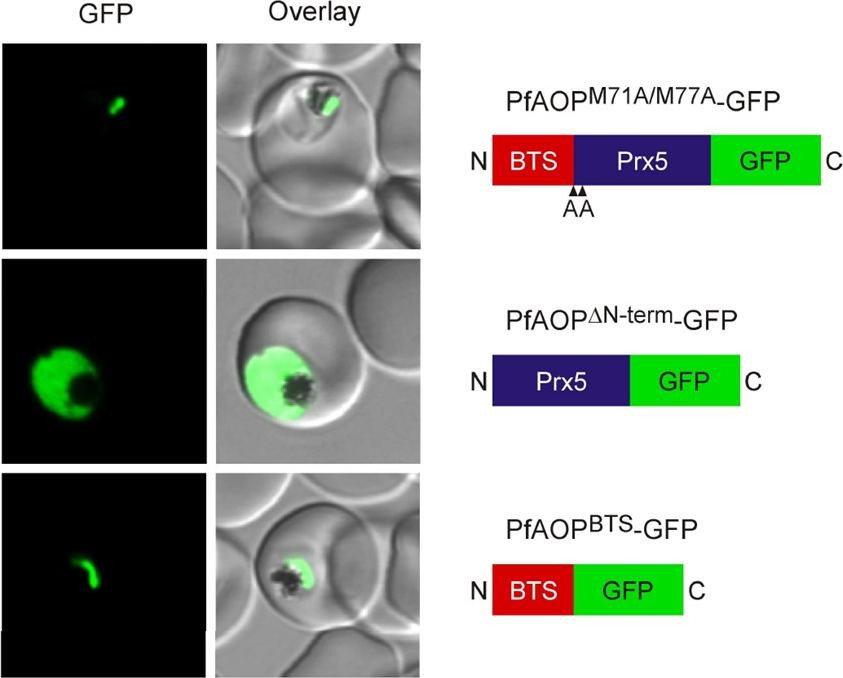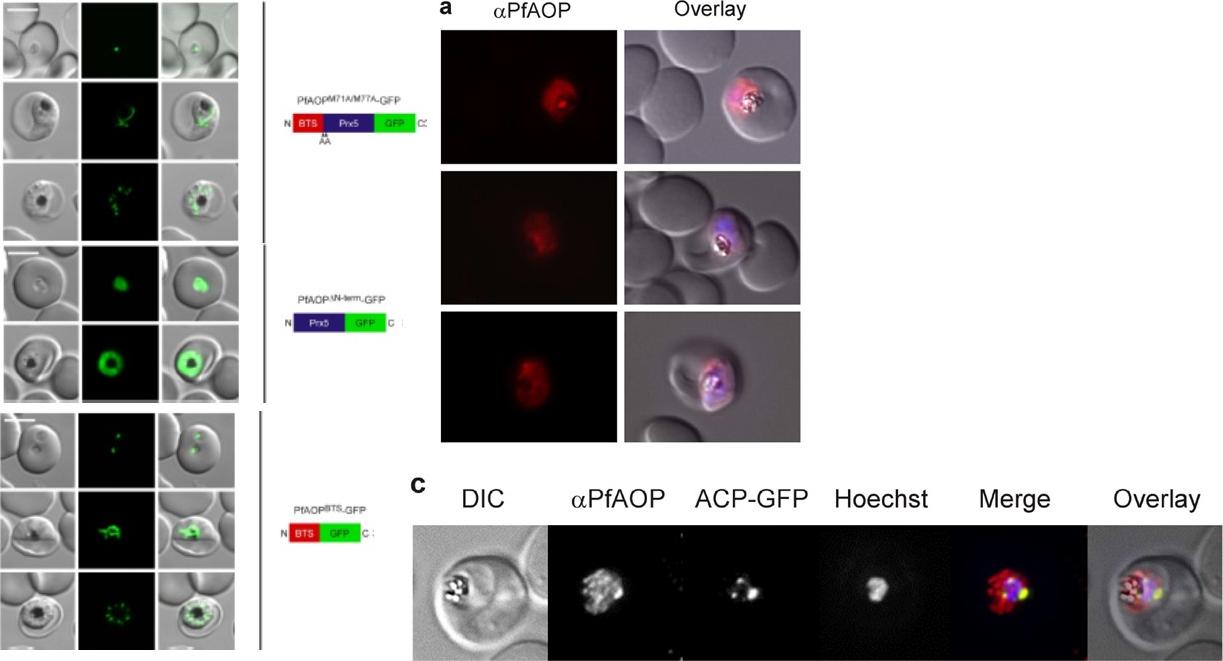PF3D7_0729200 1-cys peroxiredoxin (AOP)
Disruptability [+]
| Species | Disruptability | Reference | Submitter | |
|---|---|---|---|---|
| P. falciparum 3D7 |
Possible |
28667301 No effect on growth rate or artemisinin-susceptibility |
Theo Sanderson, Wellcome Trust Sanger Institute | |
| P. falciparum 3D7 |
Possible |
USF piggyBac screen (Insert. mut.) | USF PiggyBac Screen | |
| P. berghei ANKA |
Possible |
PlasmoGEM (Barseq) | PlasmoGEM | |
Mutant phenotypes [+]
| Species | Stage | Phenotype | Reference | Submitter |
|---|---|---|---|---|
| P. falciparum 3D7 | Asexual |
No difference |
28667301 No effect on growth rate or artemisinin-susceptibility |
Theo Sanderson, Wellcome Trust Sanger Institute |
| P. berghei ANKA | Asexual |
No difference |
PlasmoGEM (Barseq) | PlasmoGEM |
Imaging data (from Malaria Metabolic Pathways)

GFP targeting by various P. falciparum redox proteins. (A) Apicoplast targeting of the AOP N-terminus. (B) Dual localization (cytosol and apicoplast) of the TPxGl N-terminal amino acid sequence. (C) ER-targeting of Trx3. (D) Mitochondrial targeting of Tlp2. (E) Mitochondrial targeting of GLP3. (F) Apicoplast targeting of the GILP N-terminal sequence. Colocalization of GFP with the mitochondrial dye MitoTrackerOrange in fixed cells. Colocalization of GFP and the apicoplast marker ACP PFB0385w or the ER marker BiP PF11_0098 in fixed, immunodecorated cells. Kehr S, Sturm N, Rahlfs S, Przyborski JM, Becker K. Compartmentation of redox metabolism in malaria parasites. PLoS Pathog. 2010 6:e1001242.
See original on MMP
The modular gene architecture reflects the dual localization of PfAOP. Confocal live cell imaging of blood stage parasites expressing the indicated PfAOP-GFP chimera. The BTS is necessary and sufficient to target PfAOP to the apicoplast, as revealed by fluorescence microscopy and subcellular fractionation assays with transgenic parasites expressing different GFP-tagged PfAOP constructs. Removal of the N-terminus in PfAOPΔN-term-GFP abrogated the apicoplast targeting, whereas constructs with mutated methionine residues at the start of the Prx5 domain (PfAOPM71A/M77A-GFP) or without the C-terminal Prx5 domain (PfAOPBTS-GFP) were found exclusively in the apicoplast.Djuika CF, Huerta-Cepas J, Przyborski JM, Deil S, Sanchez CP, Doerks T, Bork P, Lanzer M, Deponte M. Prokaryotic ancestry and gene fusion of a dual localized peroxiredoxin in malaria parasites. Microb Cell. 2015 2(1):5-13.
See original on MMP
Dual localization of PfAOP. (A) Immunofluorescence localization of PfAOP in blood stage parasites. (C) Co-localization analysis of PfAOP and a chimera of acyl-carrier protein and GFP (ACP-GFP) as an apicoplast-localized marker protein. Left, upper panel: a rather strong fluorescence was detected in the parasite cytosol. Left: Cytosolic or apicoplast localization of mutated and truncated GFP-tagged PfAOP. Additional confocal live cell images of blood stage parasites expressing the indicated PfAOP-GFP chimera. Early trophozoite to late schizont stage parasites are shown from top to bottom for each construct. Scale bar, 5 μm. Unprocessed full length PfAOP was not observed.Djuika CF, Huerta-Cepas J, Przyborski JM, Deil S, Sanchez CP, Doerks T, Bork P, Lanzer M, Deponte M. Prokaryotic ancestry and gene fusion of a dual localized peroxiredoxin in malaria parasites. Microb Cell. 2015 2(1):5-13.
See original on MMPMore information
| PlasmoDB | PF3D7_0729200 |
| GeneDB | PF3D7_0729200 |
| Malaria Metabolic Pathways | Localisation images Pathways mapped to |
| Previous ID(s) | MAL7P1.159 |
| Orthologs | PBANKA_0213300 , PCHAS_0211700 , PKNH_0213800 , PVP01_0214900 , PVX_081760 , PY17X_0214700 |
| Google Scholar | Search for all mentions of this gene |